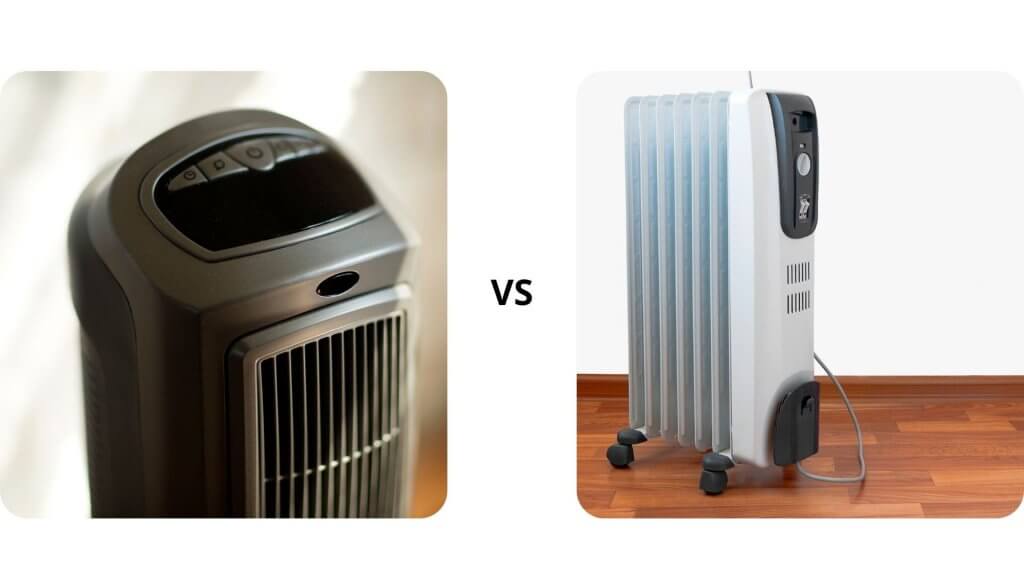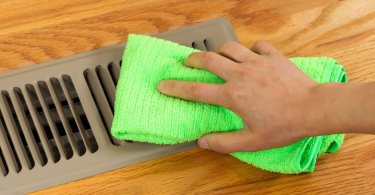Electric space heaters are an excellent way to heat any space in your house. But when it comes to selecting an electric space heater, two options are often hotly debated: ceramic vs. oil-filled heaters.
While there are pros and cons to using either, the winner would be the one which suits your needs.
To understand whether a ceramic or an oil-filled heater is the best suitable for your situation, let us look at how each of them works and their pros and cons.

What Are Ceramic Heaters, and How Do They Work?
A ceramic heater is an electric space heater that produces heat by heating a ceramic element. As electricity flows through the ceramic heating element, it heats up.
Although they are named ceramic heaters, they are not entirely made of ceramic. These heaters have a plastic body with a ceramic heating element.
The ceramic heating element has a self-regulating positive temperature coefficient (PTC). It ensures that the ceramic does not overheat.
The ceramic heating element can heat up to 518 degrees Fahrenheit. The PTC ensures that the ceramic heaters do not overheat, and as a result, the heaters don’t provide consistent heat.
A ceramic heater can be either a convection or a radiant heater. A radiant ceramic heater uses electricity to warm the ceramic heating element, which, once warmed, radiates heat into the space.
At the same time, a convection ceramic heater has a fan that blows air into the hot ceramic parts to regulate the hot air in the room quickly.
A radiant heater heats the objects in a space to make the space warmer. In comparison, a convection heater heats the air inside the room.
What Are Oil-Filled Heaters, and How Do They Work?
From oil-filled heaters, you must think that these heaters use oil as fuel to heat a space. But that is not the case. An oil-filled heater has oil inside its elements, but instead of using it as fuel, it is used as a heating element.
An oil-filled heater works similarly to a ceramic heater. Electric heating elements are used to heat the oil in the fins of these heaters. You don’t have to replace or refill the oil as it never burns, it just heats up.
An oil-filled heater heats a space using oil, an internal resistor, and thermal convection.
The oil can retain heat for a long time and continues heating the space for hours even if you turn off the heater. The internal resistor has electrons move through it, and the friction results in heating the oil, which warms the space. Thermal convection draws the air inside the oil heater, heats it, and disperses it in the room.
Related article: How Many Watts Does a Space Heater Use?
Which One Is the Right Choice for You?
Now that you know how both heaters work, knowing their advantages and disadvantages will help you determine which one of them is the right choice for you. Let us look at the pros and cons of Ceramic and Oil-filled heaters.
Ceramic Heaters Pros
Instant Heat
A ceramic heater provides instant heat to anyone who sits near the heater. With a fan to speed things up, a ceramic heater will heat a room far sooner than an oil heater. It is ideal for situations when someone requires instant heat.
Safe to Touch
Since the heater’s exterior is made of plastic, it does not burn if someone accidentally touches it.
Spot Heating
With a ceramic heater with a fan, you can direct the heat to any specific location that remains too cold for your liking. You can also keep it near your bed to stay warm and comfortable throughout your sleep.
Safe to Use
Ceramic cools down quickly. Once you turn it off, it will stop heating. If you have kids and pets, you can ensure that nobody gets burnt by shutting off the heater when you leave the room.
Portability
Ceramic heaters have a small size and thus are easy to carry from one space to another. It is the best choice if you are looking for a heater that can move along with you.
Reasonable Cost
Compared to an oil heater, ceramic heaters are far more reasonably priced. Depending upon the size and model of the heater, you can find one for between $30-$60.
Ceramic Heaters Cons
Noise
Since a ceramic heater contains a fan, it will produce noise while operating. If loud noise concerns you, some models make less noise. Check the noise decibel level before you make your purchase.
Heat Loss
Since the ceramic has PTC, it will turn the heat on and off to avoid overheating, which will result in temperature fluctuations and heat loss.
Difficult to Clean
The fan and the heating elements attract dust and need regular cleaning. Cleaning the ceramic space heater requires taking apart all the parts, making cleaning difficult.
Bad for Allergies
The air from the fan blows allergens around the room, making a ceramic space heater a terrible choice for people with allergies.
Oil-Filled Heaters Pros
Quiet
An oil-filled heater does not have a fan and thus has a quiet operation. Being almost noise-free makes them an excellent choice for rooms where you don’t want any disturbances, like your media room or bedroom.
Energy Efficient
The oil inside the oil-filled heaters retains heat and can stay warm for hours. An oil-filled heater with a thermostat will shut off once it reaches a specific temperature. Using lesser electricity lowers your energy bill while still keeping your space warm.
Allergen-Free
Since oil-filled heaters offer radiant heating, they are a better choice for allergy sufferers. Without a fan, you don’t have to worry about air-borne allergens flying around the room.
Suitable for Large Spaces
Oil-filled heaters will be more effective in heating large spaces with their large size. The unique design of the oil-filled fins offers a large heating area ideal for heating large spaces like garages or basements. While no space heater alone would be enough to heat a vast room, an oil-filled heart does a far better job when compared to ceramic heaters.
Long-Lasting Heat
The oil inside the fins of the heater remains and retains heat for a long time. Using an oil-filled heater is the best solution if you want your space to be warm for a longer period of time.
Safety
A high-quality oil-filled heater will have built-in fire safety features. If the heater falls or tips over, the power will automatically cut off to avoid mishaps. It will also have a thermostat and sensors that will shut off the heater in case it overheats.
Oil-Filled Heaters Cons
High Setup and Maintenance Cost
An oil-filled space heater will have a high initial cost. A high-quality heater will have features like auto shut-off and anti-tip, increasing costs. Also, repairing an oil-filled heater will require hiring a professional to open the unit, which will result in possible high maintenance costs.
Hot to Touch
Another major con of an oil-filled space heater is they pose a safety risk to children and pets. The outer surface of these heaters is hot to the touch. If the heater has been kept on for longer and someone accidentally came in contact with it, it can result in skin burns.
An oil-filled heater is not the right choice for someone who has kids and pets. If you prefer an oil-filled heater, keep an eye on it while it is in use. Also, give it an hour to cool down completely after turning off the heater.
Heavy
Oil-filled space heaters are large in size, heavy, and not easily portable. Some models have wheels for better maneuverability. But even then, they are trouble moving around.
If you want a space heater that you can move from room to room, then oil-filled heaters are not the right choice for you.
Slow Heating
An oil-filled heater has a slow startup. It can take 15 to 30 minutes to heat a space to a comfortable temperature. All the makes and models of oil-filled heaters have a slow startup. An oil-filled heater is not the best solution if you are looking for instant heating.
Related article: Infrared vs Ceramic Space Heater
Wrapping Up
Both ceramic and oil-filled heaters have their advantages and disadvantages. Ultimately, it is up to you to make the decision based on your specific needs and situation and by weighing the pros and cons of each heater.





Leave a Comment